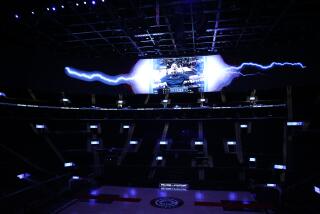The Cutting Edge: Computing / Technology / Innovation : ‘Virtual Billboard’ Is Sign of the Times
- Share via
Baseball teams would love the revenue from behind-the-batter billboards, and advertisers like the idea of being on screen without fear of remote-control zapping. But purists denounce the idea as antithetical to the tradition of the game, and some players say the signs make it harder to see the ball.
Now inventors have devised a system that will create electronic billboards visible only to people watching on TV. Princeton Electronic Billboards Inc. in Princeton, N.J., has been testing “virtual billboards” with the Baltimore Orioles and its telecasters. Working with the David Sarnoff Research Center, the firm developed a computerized system that inserts images electronically into TV shows.
Before a game, the TV cameras scan the arena and “memorize” features of the park, such as creases in the padded wall behind home plate and other boundaries that define a virtual billboard. When the camera passes those features during the telecast, the system inserts the sign, or the part of it visible in the camera’s frame of reference.
Ballplayers on the field appear to walk in front of the sign. Ideally, the TV audience will be unable to tell whether the billboard hangs in the ballpark or only in cyberspace. Local sponsors could buy a billboard in a national telecast, and a national advertiser could deliver different messages in each market.
Princeton Electronic hopes to make the system available commercially before the baseball season ends this fall.
Designed to Be Disassembled: If you think products aren’t made the way they used to be, you could be right. Anticipating the day when an old automobile or washing machine finally hits the junkyard, Rajit Gadh, a University of Wisconsin professor of mechanical engineering, is conducting research into “design for disassembly.”
Gadh’s goal is the creation of products that could eventually be taken apart as efficiently as they were put together. This would make parts easier to service and would increase the potential for the products’ recycling.
To find the ideal design, Gadh creates computer-generated three-dimensional models of geometric shapes interconnected like a jigsaw puzzle. From these thousands of models, he looks for shapes that lend themselves to disassembly. Engineers in Germany are particularly interested in Gadh’s research. That’s because Germany recently passed a law requiring all German-built automobiles to be recycled by the manufacturer.
Look, No Battery: Daimler-Benz, using experience gained in applying fuel cells to space technology, has developed an electric vehicle powered by a fuel cell, eliminating the need for heavy batteries.
The test vehicle, a Mercedes-Benz van known as Necar (for “new electric car”), has an electric motor powered by energy from the fuel cell, where hydrogen and oxygen from air form a chemical reaction that creates electricity. At a later stage, the hydrogen fuel will be replaced by methanol, making it possible, Mercedes hopes, to match the power output of conventional engines.
Necar has been on the road in Germany since the end of 1993 and has covered thousands of miles without any breakdown, Daimler-Benz says. But the test vehicle is still in the experimental stage. It will take several years to drastically reduce the size of the fuel cell to make it suitable for commercial use.
More to Read
Go beyond the scoreboard
Get the latest on L.A.'s teams in the daily Sports Report newsletter.
You may occasionally receive promotional content from the Los Angeles Times.










